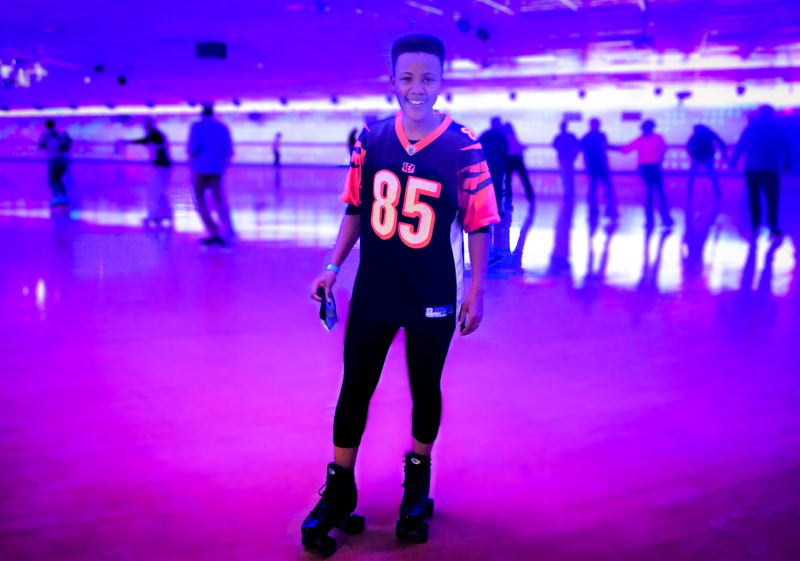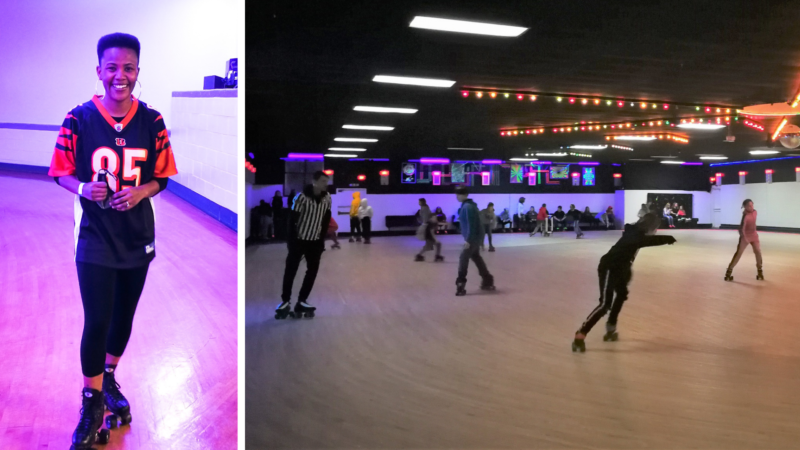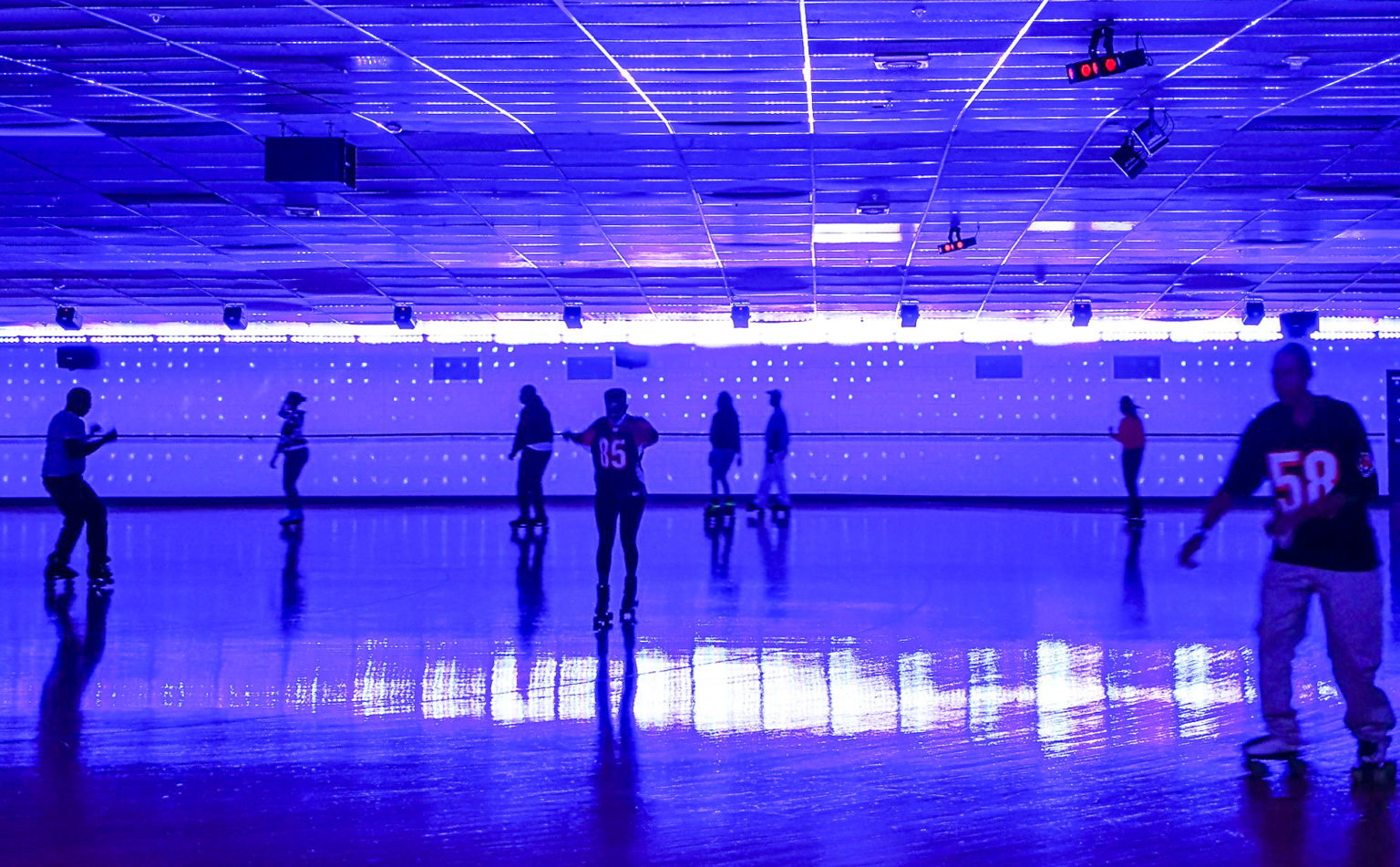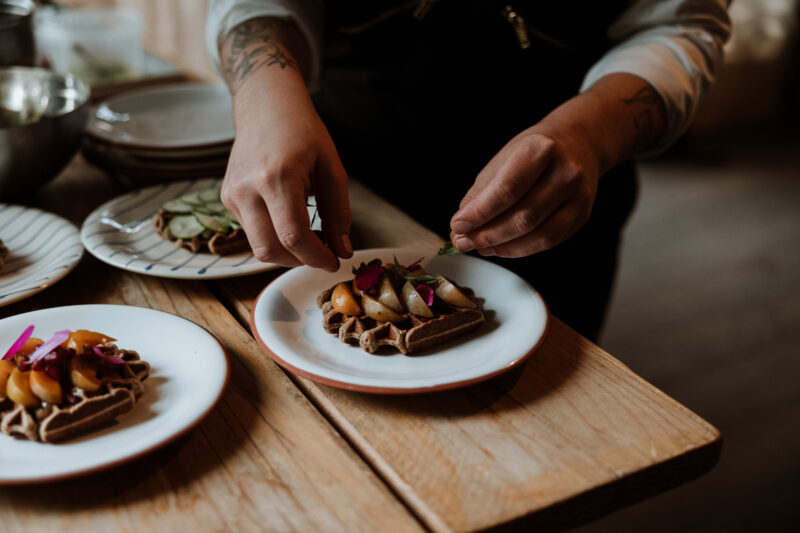Roller skating is currently experiencing a comeback in the USA. The trend is mainly driven by African-American women. For them, this is cultural heritage and a long-fought-for right to freedom.
By Marinela Potor, Cincinnati
As soon as Brittney Smith puts on her roller skates and steps onto the dance floor, nothing can stop her. The Afro-American spins in circles, goes forwards, backwards, sideways and dances without inhibitions to an R&B song the DJ is playing. It’s a 30-something event evening in the roller skating arena “The Place” in Cincinnati in the US state of Ohio. Alongside Smith, numerous other roller-skating enthusiasts are milling about. The majority are African-American. Many have been coming here for years – and they all know each other.
Greetings are exchanged, new roller skates are examined and, above all, people ride and dance together – as far as that can happen in Corona times. The atmosphere is reminiscent of a happy family celebration and it is precisely this sense of community that Brittney Smith appreciates: “We all know and love each other. The people here are your family outside of your own family.” Smith is studying history at the University of Cincinnati and is currently writing her doctoral thesis. She has two children and works a full-time job while studying.
In her hectic everyday life, roller skating offers her the only opportunity to switch off. She does this four times a week at various adult evenings, including in “The Place”. Brittney Smith also skates regularly with her children, but these evening hours are reserved as a “mental space” just for her. She explains, “When I’m on skates, I don’t think about the problems in my life. It’s like all my worries are washed away when I skate. I can completely lose myself in a movement, in a technique, in a song. It’s addictive!”
African Americans had to fight for the right to roller skate
Freedom. Joy. Family. These terms come up again and again in conversations with roller skaters this evening. For African Americans in particular, it is more than just a leisure activity. It is a right they had to fight hard for. Because there weren’t always places like “The Place“ where they were welcome. When the sport gained popularity in the US in the 1930s, the nation was still in the midst of the Jim Crow era. Brittney Smith describes this time as “100 years of segregation after the abolition of slavery in 1865”.
The basic idea of the Jim Crow laws was – even without slavery – to keep exclusively white places and activities. This meant, by implication, excluding black people from them. “In historical reprocessing, we often speak of racial segregation in education or in public spaces. But we forget that leisure time was also marked by racial segregation,” says Smith.

African-Americans were not allowed to go to the cinema or parks in many places during this time – and they were not allowed to roller-skate.
To her knowledge, there was no law explicitly prohibiting it, but African Americans were simply not allowed into the arenas, according to Smith. However, since they did not want to be banned from skating, they created their own spaces. In Chicago, for example, there was a nightclub called „The Savoy“ that allowed roller skaters on the dance floor on certain days. Black churches installed roller skating rinks between pews for parishioners. Many people converted their basements or living rooms and met there to skate.
Subculture of fashion, music and dance
Over time, a vibrant subculture emerged. African-Americans began to skate predominantly to funk and R&B, developing regional styles. Ohio, for example, is known for the so-called “shuffle”, a kind of rhythmic bobbing. Chicago, on the other hand, has the “JB style” because James Brown’s music is particularly popular there, and St. Louis has perfected ballroom dancing on roller skates.
Because many black skaters could not afford the expensive roller skates, they made them from their street shoes. This even developed into a fashion style of its own. Those who thought they were somebody, came into the arena with self-designed models.
In the 1980s and 90s, hip-hop music finally found its way into Black skate culture. Artists like Dr Dre, Queen Latifah or Salt-N-Peppa began their careers in roller skate arenas.
Non-white guests were not welcome
But even at that time, when segregation practices had long been illegal, it was not easy for African Americans to find places for their hobby. Most skating arenas were still owned by white people and many of them did not want African Americans in their halls. So they found legal ways and means to exclude non-white guests. This is a system that the documentary film “United Skates” revealed, among others.
Accordingly, some arenas deliberately did not play hip-hop, soul or R&B and when Black skaters started to bring headphones and ride to their own music, even this was banned. Often, even entering with self-designed roller skates was not allowed, nor was forming dance formations. All these bans, which were explicitly directed against Black skate culture, were justified by the arenas claiming safety concerns. However, they signalled to the African-American skaters: You and your kind of skating are not wanted here.
This is still partly the case today. That’s why Brittney Smith is grateful that there are an unusually large number of roller skating arenas in her region that welcome Black skaters. One of them is the Skateway arena in Middletown, a small town about 50 kilometres north of Cincinnati. On a Friday night, around 100 roller skating enthusiasts, mostly between the ages of twelve and 16, let loose under a glowing disco ball. Today, it’s mostly white skaters. But the owner, Linda Rall, is also deliberately trying to attract black customers.
An industry fights for survival
“Let’s face it, it’s the African-American skaters who keep our arenas alive,” she says. Because while the African-American skate community has proudly maintained roller skating culture for generations, the hobby has all but died out among white Americans. As a result, the industry is also struggling to survive to a large extent. “If you run a roller skating arena, you’re not going to get rich doing it. It’s a lot of work and not a lot of money,” Linda Rall clarifies. “I have been doing this for over 30 years because I love roller skating. I enjoy giving back to the community with my arena and providing a place where everyone can just have fun.”

In her 30 years in the business, Rall has seen a lot. When she took over her first roller skating arena in a predominantly Black neighbourhood in the city of Dayton in 1988, for example, the authorities were at her doorstep a few years later: Rall should kindly close her arena. “The city wanted to drive out the Black population and turn the neighbourhood into an affluent one with higher tax revenue.” Businesses with a predominantly Black clientele were no longer wanted. So Linda Rall had to sell her property and move her business to Middletown. She is not alone in this.
Roller skating arenas do not bring as much tax money to a city as a DIY store or a shopping mall. More and more of them are therefore being squeezed out by adjusted land-use plans. While there were still around 3,000 arenas in the USA in 1980, almost half of them had to close by 2010, writes Steven Riess in his book “Sports in America“. Currently, there are only about 1,000 arenas left, estimates the Roller Skating Association International. Linda Rall is one of the few who nevertheless managed to stay afloat. But then came Corona.
Corona makes roller skating a trend sport
The pandemic and the associated lockdowns initially hit roller skating arenas like “Skateway” very hard. At the same time, in the wake of closed discos, cafés and gyms, many young people discovered roller skating as a street-appropriate leisure activity. As a result, roller skates have been in short supply in the USA since 2020. Black and Brown women in particular are driving this development. US female influencers such as Mala Muñoz or Liliana Ruiz for example, ensured with viral social media videos that roller skating is considered a new trend sport among young people.
And in the arenas, it is an increasing number of Black women like Brittney Smith who are looking for a balance to family and professional life – and thus find their way back to roller skating. This trend reinforces Brittney Smith’s plans to open her own arena. This would make her the first Black woman to own a roller skating arena in Cincinnati and the second in all of Ohio.
Like Rall, Smith is less concerned with making money. Rather, she wants to offer the African-American community in her city a place where both adults and children can play sports and have fun. Following the motto “Black Joy Matters”, Brittney Smith wants to create a space where everyone can feel comfortable and no one is judged. She says in parting, “You can be who you really are. Roller skating is freedom on wheels!”











